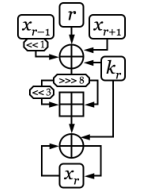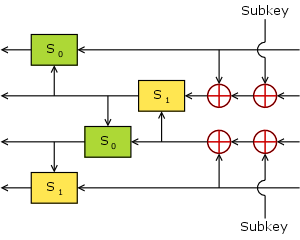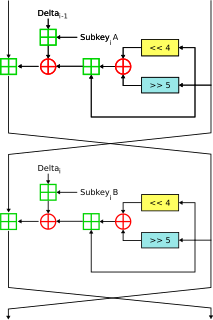 W
WIn cryptography, CAST-128 is a symmetric-key block cipher used in a number of products, notably as the default cipher in some versions of GPG and PGP. It has also been approved for Government of Canada use by the Communications Security Establishment. The algorithm was created in 1996 by Carlisle Adams and Stafford Tavares using the CAST design procedure.
 W
WThe Cryptomeria cipher, also called C2, is a proprietary block cipher defined and licensed by the 4C Entity. It is the successor to CSS algorithm and was designed for the CPRM/CPPM digital rights management scheme which are used by DRM-restricted Secure Digital cards and DVD-Audio discs.
 W
WIn cryptography, DEAL is a symmetric block cipher derived from the Data Encryption Standard (DES). The design was proposed in a report by Lars Knudsen in 1998, and was submitted to the AES contest by Richard Outerbridge.
 W
WEnRUPT is a block cipher and a family of cryptographic algorithms based on XXTEA. EnRUPT hash function was submitted to SHA-3 competition but it wasn't selected to the second round.
 W
WIn cryptography, FEAL is a block cipher proposed as an alternative to the Data Encryption Standard (DES), and designed to be much faster in software. The Feistel based algorithm was first published in 1987 by Akihiro Shimizu and Shoji Miyaguchi from NTT. The cipher is susceptible to various forms of cryptanalysis, and has acted as a catalyst in the discovery of differential and linear cryptanalysis.
 W
WThe GOST block cipher (Magma), defined in the standard GOST 28147-89, is a Soviet and Russian government standard symmetric key block cipher with a block size of 64 bits. The original standard, published in 1989, did not give the cipher any name, but the most recent revision of the standard, GOST R 34.12-2015, specifies that it may be referred to as Magma. The GOST hash function is based on this cipher. The new standard also specifies a new 128-bit block cipher called Kuznyechik.
 W
WIn cryptography, ICE is a symmetric-key block cipher published by Kwan in 1997. The algorithm is similar in structure to DES, but with the addition of a key-dependent bit permutation in the round function. The key-dependent bit permutation is implemented efficiently in software. The ICE algorithm is not subject to patents, and the source code has been placed into the public domain.
 W
WIn cryptography, LOKI97 is a block cipher which was a candidate in the Advanced Encryption Standard competition. It is a member of the LOKI family of ciphers, with earlier instances being LOKI89 and LOKI91. LOKI97 was designed by Lawrie Brown, assisted by Jennifer Seberry and Josef Pieprzyk.
 W
WSimon is a family of lightweight block ciphers publicly released by the National Security Agency (NSA) in June 2013. Simon has been optimized for performance in hardware implementations, while its sister algorithm, Speck, has been optimized for software implementations.
 W
WIn cryptography, the Tiny Encryption Algorithm (TEA) is a block cipher notable for its simplicity of description and implementation, typically a few lines of code. It was designed by David Wheeler and Roger Needham of the Cambridge Computer Laboratory; it was first presented at the Fast Software Encryption workshop in Leuven in 1994, and first published in the proceedings of that workshop.
 W
WIn cryptography, Twofish is a symmetric key block cipher with a block size of 128 bits and key sizes up to 256 bits. It was one of the five finalists of the Advanced Encryption Standard contest, but it was not selected for standardization. Twofish is related to the earlier block cipher Blowfish.
 W
WIn cryptography, XTEA is a block cipher designed to correct weaknesses in TEA. The cipher's designers were David Wheeler and Roger Needham of the Cambridge Computer Laboratory, and the algorithm was presented in an unpublished technical report in 1997. It is not subject to any patents.
 W
WIn cryptography, Corrected Block TEA is a block cipher designed to correct weaknesses in the original Block TEA.